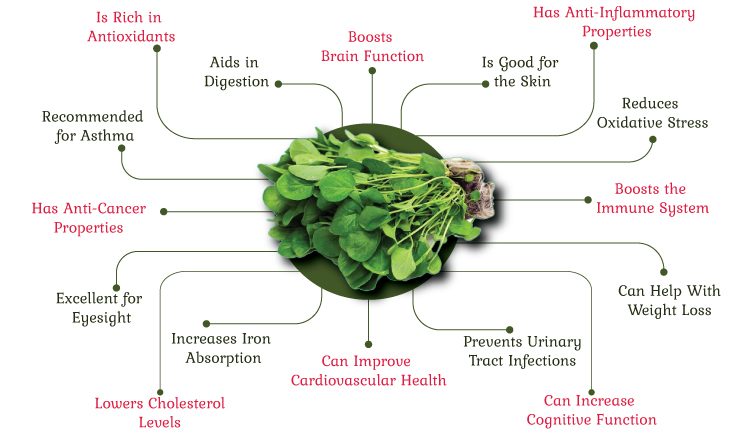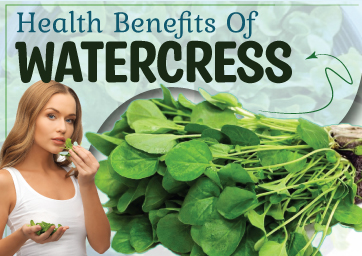Is Watercress Good for you?
The leafy green vegetable contains high amounts of vitamin C, folate, fiber, iron, and manganese. Watercress is also rich in antioxidants, vitamins A and K, and omega-3 fatty acids. Watercress's nutrition content makes it a good choice for those looking to improve their diet.
You can eat Watercress as a snack or add it to salads, sandwiches, soups, and wraps. If you do not like the taste of Watercress, try adding some lemon juice to make it more palatable.
Nutritional Value of Watercress
Watercress vegetable is a superfood. Watercress provides approximately:
● 100% of the daily recommended intake of vitamin K
● 25% of the daily recommended amount of vitamin A
● 24% of the daily recommended amounts of vitamin C
● 23% of the daily recommended level of folate
● 4% of the daily recommended doses of calcium
● 4% of the daily recommended daily intake of manganese
17 Health Benefits of Watercress
Okay, we know that you are surprised that there can be so many health benefits of Watercress. But believe it or not, it's true.
So let's not waste time and explore all the watercress health benefits.

1. Is Rich in Antioxidants
Antioxidants help protect cells from free-radical damage and are especially beneficial for the skin. But that's not all. Antioxidants also help protect us from diseases like cancer and are essential for keeping our immune system strong. So next time you're looking for a healthy snack, reach for a handful of watercress leaves and add them to your salad!
2. Has Anti-Inflammatory Properties
Watercress is quite effective at reducing inflammation.
You see, Watercress contains polyphenols and antioxidants, which lessen inflammation. This not only keeps your body operating at its peak, but it can also help stop the onset of illnesses like arthritis and joint discomfort.
3. Can Improve Cardiovascular Health
- When it comes to your heart health, Watercress is a superhero. It helps keep your arteries clear and functioning well, keeping your heart healthy and happy. It can also assist in lowering blood pressure and lowering the risk of heart attack or stroke.
4. Aids in Digestion
One of the primary benefits of Watercress is that it aids in digestion. So if you're feeling bloated or constipated, Watercress can help get things moving again. It also helps detoxify the body, a great way to flush out any toxins lurking.
5. Boosts the Immune System
Watercress is loaded with nutrients that can boost your immune system and keep you healthy and strong. Some essential nutrients in Watercress include vitamins A, C, and E, calcium, magnesium, and potassium.
6. Is Good for the Skin
Did you know that watercress vegetable is good for the skin? It's true! The vitamins A and C in Watercress are excellent sources for maintaining healthy skin. Vitamin C and vitamin A support the formation of collagen, which is necessary to keep your skin looking young and healthy.
7. Can Help With Weight Loss
Here's something you may not know: watercress leaves can help with weight loss. How? Watercress is an excellent source of fiber, which helps you feel fuller and more extended and keeps your digestive system functioning correctly.
Plus, Watercress is low in calories and high in nutrients, which means it's a great addition to any weight loss diet. So add Watercress to your list of go-to foods if you want to shed those extra kilos fast.
8. Can Increase Cognitive Function
When you add Watercress to your diet, you're also improving cognitive function. It means that your brain will work better, and you'll be able to think more clearly. You'll be less forgetful, and you'll have a better memory. Plus, Watercress can help protect your brain from age-related damage.
9. Has Anti-Cancer Properties
When you hear the word "cancer," you probably imagine all the dreadful things that could occur. But what if Watercress may help lower your risk of developing cancer? It is real!
Watercress is a cruciferous vegetable with a higher glucosinolate content than other cruciferous vegetables like Cabbage, Broccoli, Radish, Turnip, etc. It has been demonstrated that glucosinolates prevent the development of cancer cells.
10. Excellent for Eyesight
Due to the high levels of lutein and zeaxanthin in Watercress, it aids in maintaining good vision. These are potent antioxidants and aid in the prevention of macular degeneration.
11. Lowers Cholesterol Levels
Research shows that consuming Watercress lowers cholesterol levels while increasing HDL (good) cholesterol. People who eat two servings per week of Watercress have significantly lower total cholesterol than those who do not eat Watercress.
12. Increases Iron Absorption
Some studies show that Watercress enhances iron absorption by about 25%. Iron keeps our bodies strong and healthy. Without enough iron, we cannot produce hemoglobin, the protein that carries oxygen throughout the body.
13. Prevents Urinary Tract Infections
Studies suggest that Watercress can prevent UTIs, a type of infection that affects the bladder and urethra. UTIs affect millions of people worldwide annually. Drinking two glasses of watercress juice daily can significantly reduce the chance of contracting a UTI.
14. Recommended for Asthma
Watercress is often recommended for people who suffer from asthma and allergies. Asthma is a disease where the airways become inflamed due to various reasons. Watercress is known to have anti-inflammatory properties and is often recommended for people with asthma. Further, Vitamin C, plentiful in Watercress, helps fight infections and reduce inflammation.
15. Reduces Oxidative Stress
Free radicals are unstable molecules in our bodies. The free radicals are very reactive in the presence of oxygen and cause oxidative stress. Watercress contains a lot of beta-carotene and other carotenoids, which are thought to be potent antioxidants. These antioxidants counteract oxidative stress and combat free radicals.
16. Boosts Brain Function
Watercress has a low-fat content by nature. But it has plentiful alpha-linolenic acid. It's an essential fatty acid and the parent of the family of omega-3 fatty acids. Regular consumption of Watercress can contribute valuable amounts of omega-3 fatty acids to the diet.
Omega-3 fatty acids may aid with mood, memory, and brain function. Additionally, they are suitable for heart health since they lower triglyceride levels and protect blood arteries.
17. Helps in DNA Synthesis and Repair
Watercress is an excellent source of folate, which is necessary for proper DNA synthesis and repair. Folate also helps prevent specific congenital disabilities, including neural tube defects such as spina bifida.
All that from a little green vegetable? Isn't it just amazing!
Watercress should therefore be at the top of your list if you're seeking a way to stay healthy and active.

How to Eat Watercress?
Watercress is highly versatile, making it great for salads, sandwiches, soups, stir-fries, and pasta dishes. You can also use it in smoothies, omelets, pasta dishes, and baked goods.
Here are some ways to enjoy the benefits of Watercress:
• Add chopped Watercress to soups, stews, and sauces.
• Top grilled fish, chicken, beef, lamb, pork, and tofu dishes with chopped Watercress.
• Use Watercress as a garnish for salads, pasta, rice, potatoes, and vegetables.
• Mix chopped Watercress into mashed potatoes, polenta, couscous, or brown rice.
• Make a smoothie using fresh Watercress instead of spinach.
• Use water-packed Watercress as a sandwich filling.
• Sprinkle chopped Watercress on top of omelets.
• Steam Watercress until tender and then serve topped with lemon juice.
Tips to Buy Watercress
Here are some tips on buying only the best Watercress:
1. Choose Freshly Harvested: When buying Watercress, choose fresh-picked specimens that have not been sitting around for a long time. If they look wilted or limp, they may no longer be edible.
2. Look for Small Leaves: Watercress should only have small, tender leaves. Avoid any leaves that appear dry or yellowish.
3. Pick Locally: Buy locally grown Watercress if possible. If you buy wilted Watercress, rinse off any dirt before using it. Also, Store it in the refrigerator until you're ready to use it.
● If you plan to make soup with it, use it right away.
● If you plan to eat it raw, let it sit out for 5 minutes before eating.
Possible Side Effects of Watercress
Like any other food, it's essential to be aware of possible watercress side effects before adding it to your diet.
For example, it can interact with certain medications, so be sure to speak with your doctor if you're taking any prescription drugs.
Watercress can also cause an allergic reaction in some people, so if you experience any adverse effects after eating it, be sure to stop immediately and consult a healthcare professional.
Final Words
There you have it! You now have 17 excellent reasons to add watercress nutrition to your meals or snacks.
You may add Watercress to any dish where spinach is commonly added. And the best part is that Watercress is so versatile:
● You can add chopped Watercress to salads, soups, sandwiches, pasta dishes, and casseroles.
● You can use Watercress as a garnish for soups, stews, stir-fries, and rice dishes.
So next to them, you are out buying groceries, do yourself a favor. But these leafy greens add the benefits of Watercress to your diet.



 Contact Us
Contact Us

 Hospitals
Hospitals
 Doctors
Doctors
 Diagnostic
Diagnostic
 Pharmacy
Pharmacy
 Health Tips
Health Tips
 Blog
Blog


















Comments